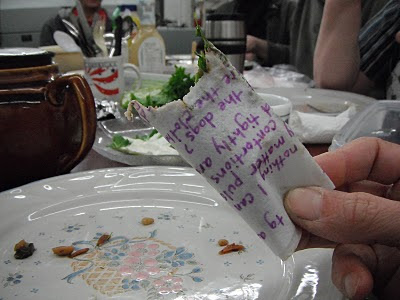
Steven Slipp cooking smelts
For pushing a decade now, I’ve been getting together sporadically with a group of local fellows for what I can only describe as an anti-book-club meeting. That is, we don’t all read the same book and then get together to discuss what we liked or didn’t like about that book, like some high school English class for adult learners. No, when we get together we all sweep bound contents of our bedside tables into a rucksack and bring our individual adventures in reading to share and debate with the other fellows. More often than not, we talk as much about what is afoot in local politics and the media as we do about the books. I suppose in many ways you’d more properly call this sort of thing a salon, but that sounds a little too urbany coming out of my spruce-gum-scented mouth.

Ed Thomason and Steven Slipp (and a fried smelt)
The most recent salon was hosted by Stephen Anderson, a bonne vivant who works in international development in the area of food aid and ‘rural livelihoods’, commuting between Wolfville and Africa. When I arrived, Steven Slipp was displaying his catch of smelt, presently running up the Gaspereau River on the incoming tides.(Steven is a local designer whose work you’ve likely seen if you’ve ever licked a postage stamp in this country – the loon, the polar bear and the moose stamps to name a few – or followed a wayfinding sign in Halifax Airport)
Also present were Michael Cussons (Irish-born country doctor, bicycle enthusiast, and James Joyce booster) and Ed Thomason (English-born playwright, director, Bob Dylan fanatic and the present executive director of Festival Antigonish). There are other members of the this salon, but I’ll punish them for their non-attendence by not mentioning them here. Better show up next time guys.

The rabble: Myself, Michael Cussons and Ed Thomason
The books I took to discuss were a history of the Doves Press, George Walker’s graphic novel about the day before the World Trade Center attacks (Book of Hours, published by Tim Inkster at the Porcupine’s Quill), The Etiquette of Freedom (interviews with Gary Snyder and Jim Harrison, published by Jack Shoemaker at Counterpoint), and a catalogue Francis Meynell did for the Pelican Press. There was a rather involved discussion about purpose created content (as in whether a film made for the big screen really could ever be at home on an ipod screen), prompted in part by Michael’s expressed desire to see George Walker’s engravings from Book of Hours dispayed framed on the wall instead of bound into a book (and was it really a novel anyway, where was the text?). We also had a long talk about how, despite his old-fashionedness, Dickens often seems to have a much broader scope and is able to communicate a much broader and much more detailed picture than most modern novelists. This was prompted by Ed’s bringing Dickens’ Dombey and Son. He was going to read aloud from it, but I made the mistake of asking him if he felt there were any similarities between Dickens writing his novels in bits and pieces for periodicals and Ed’s own work on radio plays broadcast in series, and we never got back to his reading from Dickens. As is typical of these gatherings, the books often get left behind as we follow this or that thread, follow it until we’ve completely lost our way or something brings us around to someone else’s book with a "well it's funny that you would mention French Impressionism, because I’ve just been reading ..."

Michael: "Good lord! Thoreau again! Enough of it. Let's get back to Ulysses."
Anyway, after much wine and chatter about books and reading, I’m afraid that it all descended into Ed, Stephen and I playing music until nearly 2:00 am.
ANDREW STEEVES ¶ PRINTER & PUBLISHER










































